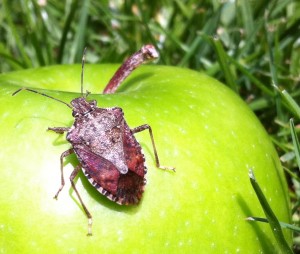By Kira Hess –
What’s eating Gilbert’s grapes?
The brown marmorated stink bug (BMSB) has been affecting us all. They are outside, in our homes, and their stink goes up our nose. To most of us, they are just an annoying pest. However, the damage they do to our farmers crops is devastating. Local farmers are gearing up to fight the stink bug as the bugs are planning a fresh attack on what our county is known for – fresh produce.
First found in Allentown, Pa. in 1998, the stink bug is now in 33 states in the United States. According to the United States Department of Agriculture (USDA), the stink bug damaged 20 to 100 percent of the fruit crops in some areas last year.
The stink bug feeds on all fruits and vegetables.

“Damage can be seen by observing a sunken appearance in the surface of fruit. Evidence of feeding is left under the skin in the flesh and shows as a dark spot,” said Tom Haas, owner of Cherry Hill Orchards which is located in New Danville.
The insects can be controlled by direct insecticide applications. “You can spray for them, and it will only kill what’s there so more can come in. You have to spray continuously,” said Haas. “Prevention from BMSB feeding is difficult.”
“It’s a very timely and costly thing,” said Robert Bachman, a farmer in Washington Boro.
Adult stink bugs come out in April and May, and can produce 4-6 generations. One female can lay about 25 eggs, and can continue to do so until about September or October.
“Based on the last several seasons, it would be safe to assume that we will sustain damage again this season,” said Haas. While Bachman agreed and presumes that this year will be much worse.
The USDA is currently studying an Asian parasitic wasp, which preys on stink bug eggs. It lays its own eggs in the stink bug eggs, and when the wasp larva hatches it feeds on the developing stink bugs.
“It will be several years before this can be released, if at all. If decided that it will not cause a problem it could be released. However, it will take years for the population to build up to be able to help with control,” said Haas.
According to USA Today, researchers with the USDA are “conducting trials on four species of Trissolcus wasps to see how well they target the brown marmorated stink bug egg masses in a quarantined, lab setting. If all goes well, federal officials could one day approve the tiny wasps as a natural control for brown marmorated stink bugs.”
Bachman said, “As long as they don’t kill other beneficial bugs, don’t hurt people and they don’t turn out to be a problem, I don’t mind (the use of wasps).”